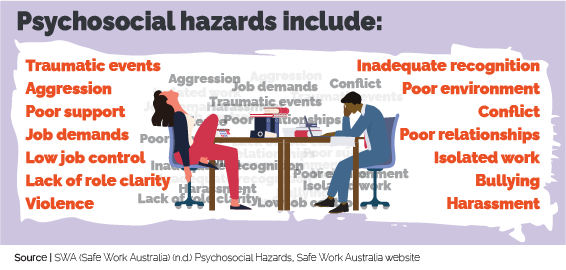
Data snapshot - Psychosocial hazards
Psychosocial hazards are anything in the design or management of work that increases the risk of work-related stress. Prolonged or severe work-related stress can cause both psychological and physical injury.

The ACT’s WHS laws require persons conducting a business or undertaking (PCBUs) to minimize risks from hazards - including work-related psychosocial hazards – so far as is reasonably practicable.
Download the infographic versions here:
National data
The main source of data for assessing the impact of psychosocial hazards in Australian workplaces is workers’ compensation claims data.

Women were more than twice as likely as men to make a serious mental stress claim. Mental stress claims comprised 13% of female serious claims and 6% of male serious claims. This difference of serious claims by gender is the largest for any mechanism of incident in the national workers’ compensation data set (SWA 2021).[1]

The median time lost for mental stress claims increased more than 130% between 2000-1 and 2019-20 – the largest increase of any mechanism of incident over this period.
ACT data
In the ACT, between 2017-18 and 2020-21, there was a combined 688 accepted private sector and ACT Public Sector (ACTPS) workers’ compensation claims due to mental stress.

Women were almost twice as likely to have an accepted mental stress claim as men (452 claims versus 236 claims).[2] The pattern of women having near or above double the number of accpted claims as men held across every age group except 55-65 and 65+.

The industry with the largest number of accepted mental stress claims was health care and social assistance, accounting for 53% of total claims.

At the level of occupation, mental stress claims were concentrated amongst professionals and community and personal service workers. Amongst professionals, claims were most common from educational professionals. Amongst community and personal service workers, the largest number of claims were by carers and aides.

WorkSafe ACT’s response
WorkSafe ACT’s psychosocial team undertook 670 workplace visits in the 2021-22 financial year. These visits resulted in 58 notices for offences related to a failure to manage psychosocial hazards in the workplace.
In October 2021, WorkSafe ACT launched its Strategy for Managing Work-Related Psychosocial Hazards 2021-23. The strategy will guide the activities of WorkSafe ACT to inform duty holders of their obligations and enforce the assessment and management of work-related psychosocial hazards in the ACT.
Resources for PCBUs and workers
WorkSafe ACT – Mental Health
Safe Work Australia - Infographic Managing Psychosocial Hazards at Work
Safe Work Australia - Psychosocial Hazards
WorkSafe Queensland – Psychosocial Hazards and Factors
References
ACT claims data provided by Workplace Safety and Industrial Relations Division, Chief Minister, Treasury and Economic Development Directorate (private sector and ACPTS claims only).
Australian Bureau of Statistics (ABS) (2022) Labour Force Status by State, Territory, Greater Capital City and Rest of State (ASGS) and Sex, accessed 20 February 2022.
SWA (Safe Work Australia) (n.d.) Psychosocial Hazards, Safe Work Australia website, accessed 14 June 2022.
SWA (2021) Australian Workers’ Compensation Statistics 2019-20, accessed 14 June 2022.
SWA (2008) Type of occurrence classification system (TOOCS) 3rd Edition May 2008, accessed 19 June 2022.
[1] In the national workers' compensation claims data set, a mechanism of incident is the “action, exposure or event that best describes the circumstances that resulted in the most serious injury/disease” (SWA 2008).
[2] During this period, women comprised approximately 49% of the ACT workforce (ABS 2022).
On this page


